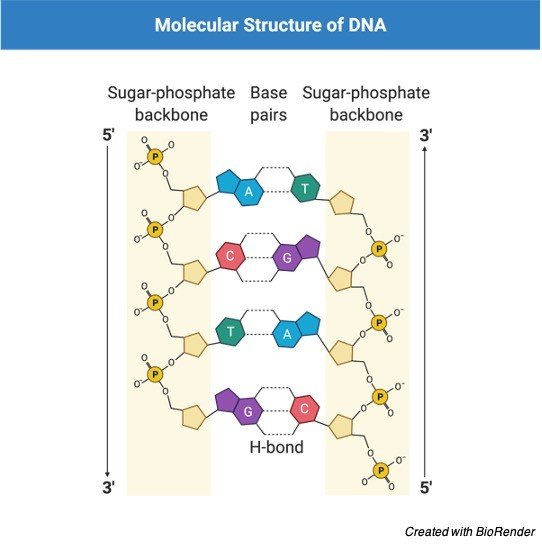About Adenine
The specific structure and function of DNA is very much important in sustaining a life.
Adenine is one of the important base pair which is also a part of the DNA. It is also one of the four nucleoid bases which forms a chemical base in the DNA.
The bases are located on one strand and pairs up with thymine which is present on the opposite side on the other strand. This sequence helps in giving up the genetic instructions to the cell.
Adenine also helps in formation of adenosine triphosphate (ATP) molecule which helps in transfer of energy between the cells.
It also paves a way for many chemical reactions to take place.

Features of Adenine
We all know that all the larger substances are made from a smaller building blocks where house or building is made up brick, stone, clay, door, windows etc. Such that DNA is also made up of substances such as sugar and phosphate bonds, nucleotides, base pairs etc.
Adenine is one of the four nucleotides present as a building block of protein.
It is usually represented in genetics with its first letter “A”. It has its own property that when it is that it always pairs up with thymine which is present of its opposite strand.
Adenine is also present in RNA and DNA. Along with it, is also present in ATP molecules. Which helps in restoring and transferring energy to the cells.
Adenine is one of the organic compounds which belongs to the group of purines and it has its own biological importance in the field of genetics and in biochemistry. As it also plays a vital role in maintaining the hereditary of the cell.
Adenine: a Critical Component of Nucleic Acid
Adenine is one of the most important living components of life. It is one of the four nitrogenous bases which are found in DNA as well as in RNA.
DNA and RNA contain specific genetic code for each organism including all the organisms such as humans, plants, fungi, etc. where it helps in giving instructions to the functioning of the cells.

Adenine also helps in stabilizing the portion of nucleic acid in these molecules of DNA or RNA.
In Adenosine Triphosphate adenine helps in storage and transporting oxygen.
Synthesis of Adenine
Adenine is generally formed from the adenylic acid and deoxyadenylic acid by the partial decomposition of ribonucleic acid and deoxyribonucleic acids which may be further separated. These acids are generally known as nucleotides.
These are considered as the phosphodiester of adenosine and deoxyadenosine that are composed of adenine and either ribose or in the form of deoxyribose.
The compounds of adenine is also involved in producing vitamin B12. As it is naturally synthesized by our body and there is no need to intake it in the form of food molecules.
Adenosine triphosphate and other co enzymes are produced which act in conjunction of enzymes.
In some cases, adenine is also known as vitamin B4 because it combines with the ribose sugar to form adenosine, in such case it binds up to three phosphoric acids which results in producing AMP or ADP or ATP.
These adenine groups are important in functioning the vital cellular mechanisms.
Adenine is considered as one of the important nitrogenous bases which are involved in the production of nucleotides. AMP, which is known as adenosine monophosphate is involved in the propagation of many hormonal stimuli by acting as an important secondary messenger.
Adenine also acts as one of the important factors of many co-enzymes. Adenosine is formed, when adenine combines with ribose group or deoxyribose group. But when adenine combines only with ribose group it causes block in the av node of the heart.
Adenosine helps in identifying the rhythm in supraventricular tachycardia affected individuals. Adenine activates when it combines with the ribose and forms an adenosine or in the form of deoxyadenosine.
In the other case when it combines with deoxyribose to form adenosine triphosphate which plays an important role in maintaining the energy functions of the cell.
Chemical Nature and Structure of Adenine
Adenine is usually made up of carbon, nitrogen and hydrogen atoms. Adenine has its chemical formula as C5H5N5.Considering the chemical nature of the adenine, it on combing with ribose and phosphate group forms a nucleotide.

Adenine is one the nucleotide which is present in the group of purines. Where the purine consists of a six membered nitrogen ring fused to a five membered nitrogen ring.
The other group of nucleotides group apart from purine is termed as pyrimidine. Where these pyrimidins has only a single ring which is much less than that of purines.
The adenine and guanine belong to the group go purine and other two bases thymine and cytosine belongs to the group of pyrimidines.
Adenine in DNA
According to the DNA model of Watson and Crick in the double helical structure of DNA, the adenine is present along the sides of the ladder that are composed of phosphate sugar groups. Where the rugs of the ladder are made up of nitrogenous bases that are adenine, thymine, guanine and cytosine where each rug has two bases and they are bonded together by hydrogen bonds.
As of its size and shape purine always pairs up with pyrimidines. Where as Adenine always pairs up with thymine and guanine always pairs up with cytosine or uracil in case of RNA.
These coupling of purine and pyrimidine base pairs are generally called as base pairs. As of DNA adenine has its same importance in RNA also But in such cases, adenine pairs with uracil as thymine is not present.
Citations
Share









